Menu
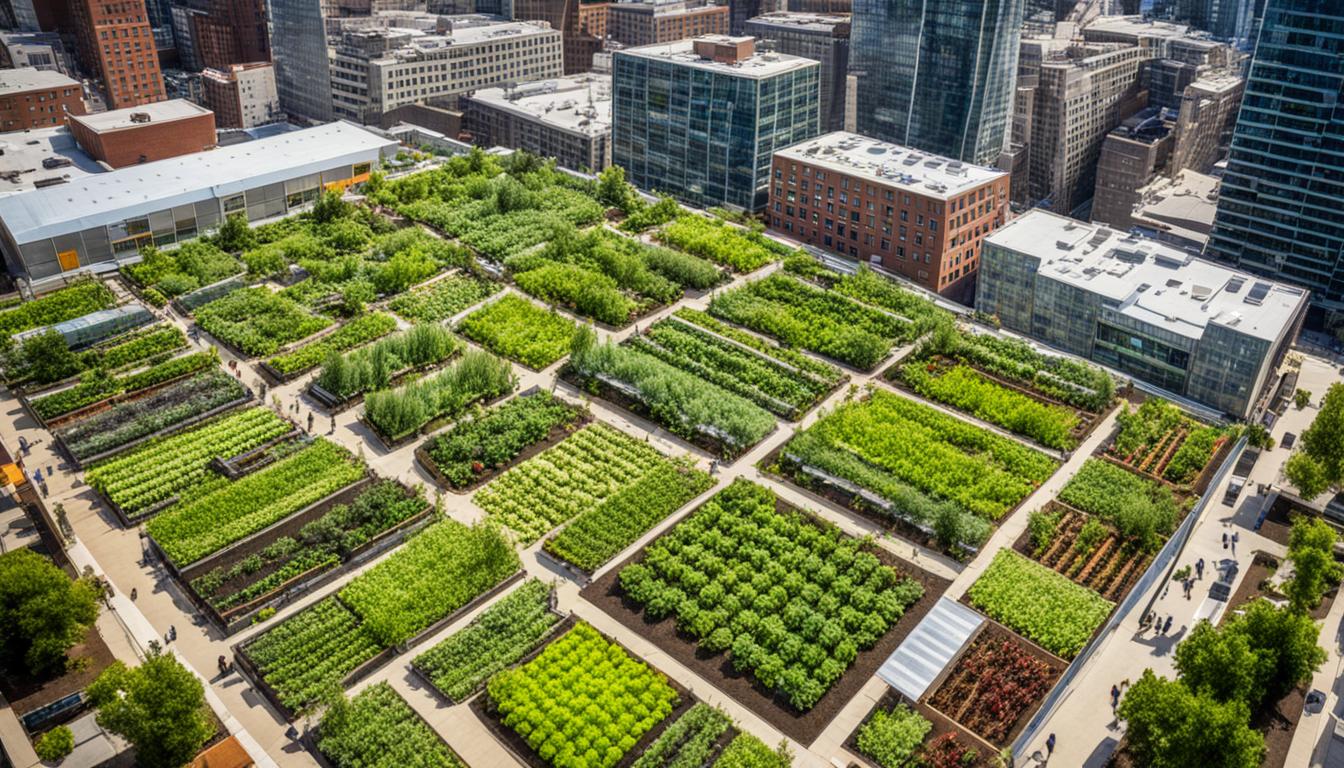
Did you know the Northeast leads in urban farms in the USA? It has 101 farms, making up 32.2% of the total. This shows how important urban farming is becoming, not just in the region but also across the country.
In the USA, urban farming is gaining popularity for making cities greener and offering fresh food. Places like New York, Baltimore, and Chicago are big on this. They are adding urban farms to their city life. These farms are using resources well and meeting the need for fresh food by city folk.
The USDA Census of Agriculture looks at farms that make at least $1,000 of products each year. Yet, it’s hard to identify urban farms in this. So, a study in 2013 looked deeper into urban farms to understand them better. They found that most urban farms don’t own their land outright; they lease it because in cities, land is very expensive. Also, many urban farms aim to help their communities. They exist to make sure people have enough to eat and to bring neighbours together. These farms take different legal forms to protect themselves and get the funding they need.
Urban farming is about growing food in cities. It turns city places into farms. People use city spaces to produce food for everyone living there. These farms range from small rooftop gardens to big areas near cities, showing a variety of ways to grow food in urban areas.
Urban farming uses different places to grow food. It uses new methods like vertical farms to grow lots in small areas. It also includes gardens on top of buildings. These efforts bring green into the city, making it look better and help with food needs.
Urban farming is not new. People have grown food in cities since ancient times. During crises like wars, these farms were key in feeding cities.
With times changing, cities expanded and technology grew. But now, people are turning back to urban farming. They want to live in more sustainable places and grow their own food.
Urban farming offers many benefits. It produces local food, turns unused areas into gardens, and brings people together. The USDA groups urban farming into four types. This includes gardens, farms, and projects by schools or companies. It shows how city farms meet many needs and encourage learning and community work.
Urban farming is for everyone. You just need soil, sun, water, and a desire to help. It not only gives fresh food but also lets people get involved, such as by starting gardens or buying from local farmers.
The USA is seeing a big increase in urban farming. It’s changing our city life and the way we grow food. Major cities are leading the charge. They’re finding ways to mix farming into city planning.
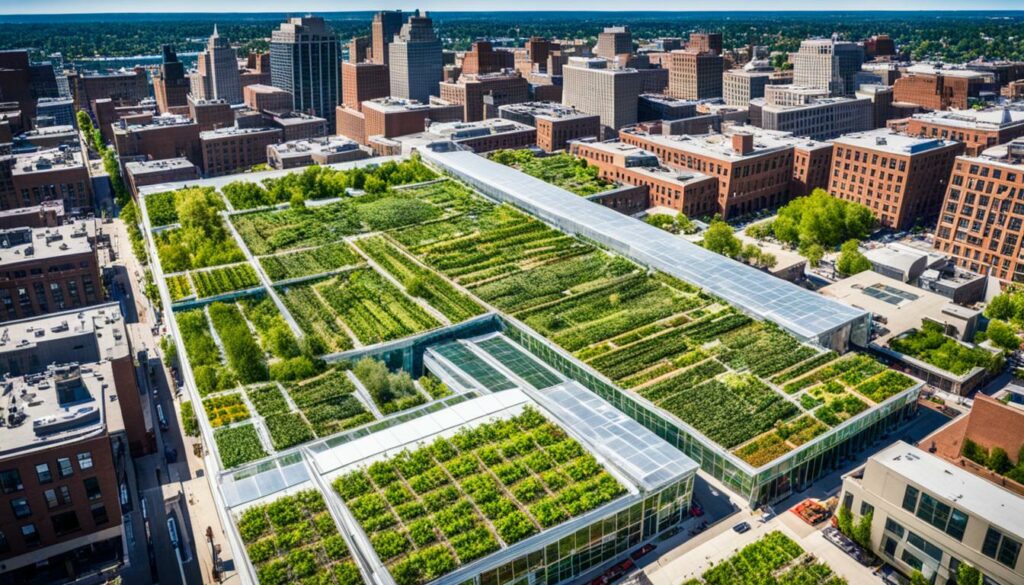
Urban farming is growing fast, especially in the Northeast. About 800 million people worldwide now do urban farming. This number is rising in the United States too, picking up pace since the 1970s.
Cities like New York, Detroit, and Washington D.C. are getting creative. They have all kinds of urban farms, from vertical ones to rooftop gardens. This variety shows there are many ways to do urban farming.
New York, Baltimore, and Chicago are leading the urban farming movement. They are coming up with new rules to support farming in the city. This shows they really want to make farming a part of city life.
Projects like the Ohio City Farm help the whole community. They give jobs and training to people who need it. Plus, living near urban farms or gardens can make you more money. It helps start new businesses that sell local food.
But, there are still tough problems to solve. In New York City, all the empty lots couldn’t grow enough food for everyone. We need smart planning and new ideas to do better in urban farming.
In conclusion, urban farming in the USA is growing, thanks to the work of many cities. To keep this going, we need to keep making good plans and really focus on this kind of farming. It’s all about making our cities greener and our food healthier.
Urban farming offers many benefits, such as helping the economy, protecting the environment, and bringing communities together. Exploring its economic benefits, positive effects on the environment, and impact on community life will show how it changes our cities for the better.
Get ready for some fascinating stuff! Urban farming isn’t just about growing food. It also creates jobs and supports local businesses, which helps the economy. By getting people, especially the young, involved in growing their own food, we see more than just tasty meals.
They also get exercise and learn to enjoy new foods. Plus, they save money on their grocery bills! So, when there’s a food shortage, these urban farms are a reliable place to turn to locally grown food. This makes our food and nutrition more secure.
City farming does a lot for our planet. It makes cities more vibrant by adding plants, animals, and insects. These areas also help bees and other pollinators by providing more habitats for them.
Then, there’s the waste. By collecting food scraps and turning them into compost locally, we cut down on landfill waste. Also, food doesn’t have to travel far from these urban farms to our tables. This means less pollution from transportation.
Now, let’s talk about how urban farms bring people together. Urban farming creates places where the community can gather and work together. Growing food in these shared spaces gives people a sense of belonging.
It doesn’t stop there. These projects make neighbourhoods feel safer and help reduce crime. They also offer fresh, healthy food that matches everyone’s culture. This supports the overall health and happiness of the community.
So, urban farming is a real win-win for economy, environment, and society. It’s clear that the benefits reach far and wide. As urban farming grows, so does its role in feeding cities and bringing people closer together.
Urban farmers often find many challenges but still play a key role in making city agriculture sustainable. One main issue they face is finding land. In busy cities, suitable land is hard to find and is costly. This problem is especially hard in poor areas where finding space for agriculture is tough because of high land prices.
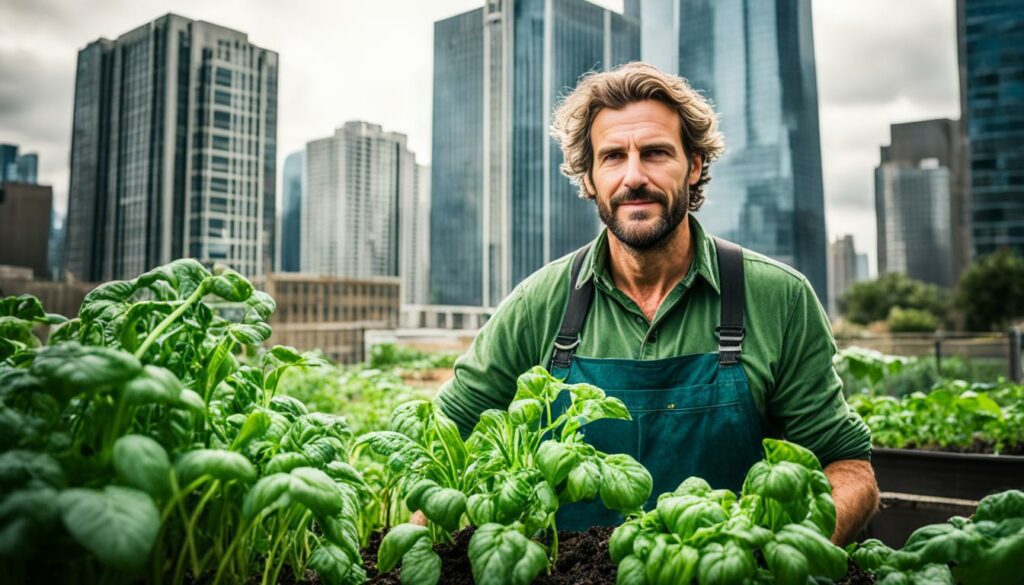
Getting land for farming in cities is a big hurdle. With too many people living in one place, there is less open space for farms. So, farmers in the city must rent or get temporary permission to use land. This makes it hard for them to plan for the future. It also slows down the growth of city farming.
City farming needs a lot of money for everything from starting up to growing the business. Farmers find it hard to get the money they need. They also struggle to find and afford good seeds and water. This is more difficult in places where water is scarce and rules limit how it’s used.
Getting help with running a city farm is very important. Farmers often turn to organisations and government programs for advice and knowledge. These groups help with all kinds of problems, from managing polluted soil to following strict laws that affect urban farming. They also provide support for things like zoning.
| Challenge | Description |
|---|---|
| Limited Space | High population density and urban sprawl reduce available land for agriculture. |
| Contaminated Soil | Urban soils often contain pollutants, posing health risks and necessitating remediation. |
| Limited Access to Resources | Challenges include water scarcity and limited availability of high-quality seeds. |
| Regulatory Barriers | Zoning laws, health codes, and food safety regulations can restrict urban farming activities. |
| Extreme Temperatures | Higher temperatures in urban areas can inhibit photosynthesis and reduce crop yields. |
| Changes in Atmospheric Conditions | Higher temperatures and humidity deficits can cause moisture stress in plants. |
Strong city agriculture policies and government support hugely impact urban farming. They offer help such as grants and advice to make farming in cities thrive.
The US government is key in making urban farming happen. The USDA leads by helping urban, small, and innovative farmers. It gives funds for community farms, rooftop gardens, and hydroponic setups.
The USDA pledged about $11.5 million to reduce food waste and aid the environment. It also launched new insurance for farmers in controlled spaces to protect their money. These steps encourage farming in cities.
NIFA and the USDA together put $9.4 million into urban agriculture research. This helps bring new farming technologies and methods to our cities. An extra $43 million from the USDA goes to city farming projects, making sure city farmers get the support they need.
Nonprofits help fill in the gaps in government efforts. They give grassroots support and push for better urban farming policies. Nonprofits like the Reinvestment Fund help the USDA by investing $22.6 million for healthier food access nationwide.
These organisations also help farmers deal with rules and find funding. Through partnerships with the USDA, they work for a more sustainable urban farming future. Efforts like the Healthy Food Policy Project and the National Agriculture Library back up their work.
Urban farming uses new ways to grow food in cities. These methods are key for turning cities into places that can grow food, making it easier for us to get food locally. This also helps the environment. Here’s a look at some top techniques in urban farming today.

With rooftop gardening, empty city roofs become green spaces. This turns city areas into places that can grow food. It also means we use space better and help more plants and animals thrive. Plus, gardens on roofs can help keep buildings cool and use less energy.
Indoor and vertical farming have changed how we think of farming in cities. They let us grow food all year in the limited space we have. By stacking plants up in buildings, we save room. This also makes sure plants are safe from pests and diseases.
Hydroponics, aeroponics, and aquaponics are some of the smartest farming methods today. In hydroponics, plants grow in water, not soil. Aeroponics grows plants in the air with a water mist. And aquaponics grows veggies with fish in a natural system. These ways use less water and can work where normal farming can’t.
| Technique | Description | Benefits |
|---|---|---|
| Rooftop Gardening | Using rooftops to grow plants | Makes use of wasted space; helps keep buildings warm or cool |
| Indoor Vertical Farming | Plants grown up high inside using shelves or towers | Can grow all year; saves space |
| Hydroponics | Plants grown in water with nutrients | No soil needed; uses water well |
| Aeroponics | Plants grown in water mist in the air | Good for plants; very effective |
| Aquaponics | Combines plant water farming with fish farming | Both plants and fish can be harvested; eco-friendly |
These farming methods show how creative and smart we can be in cities. By using rooftops, indoors, and high-tech ways of growing food, we can feed the local community. These different ways not only keep us going now but they also open the door to more new ways of urban farming.
Urban farming has grown in popularity, helping many cities tackle food insecurity and bring people together. By looking at real examples, we can understand how these projects work and their impact.
Sky Greens in Singapore is a great example. They farm vegetables vertically, using very little land. This model inspires other farms to use space efficiently in cities.
The Distributed Urban Farming Initiative in Bryan, Texas, is impressive too. It plants crops in various places, ensuring food is available locally. This approach makes the most of urban areas.
The Sharing Backyards project in Canada, the U.S., and New Zealand is also worth noting. It connects people with gardens to those without, supporting a shared farming effort. Urban farms like this show the power of working together.
In Baltimore, urban farming is helping against food issues. It provides fresh foods and reduces the need to import. This strengthens communities and takes a stand against racism in food access.
Boston stands out for its 200 community gardens managed by groups and the government. About 10,000 people take part, showing the impact of community efforts. Programs like the Community Garden Small Grant support these gardens financially.
Alternative food networks and community-supported agriculture also play a key role. They improve food security, tackle unemployment, and fight food deserts. These models boost the consumption of healthy foods in cities.
The COVID-19 pandemic has made food access issues worse. Urban farming can help in tough times, creating strong and fair food systems. As more cities adopt urban farming, these successes offer guidance for future projects.
Community gardens are key to the urban agriculture movement. They help build strong communities and make sure there’s enough food. By putting green spaces in cities, these gardens bring people together and teach about growing food in the city. Let’s look at how they do this.
Being part of city farming is vital for its success. These gardens change empty city spots into lively places where locals can grow their food. This helps people feel like they own a part of their community. In New York, a meeting on urban agriculture shows the city’s efforts to involve everyone. This was on November 2, 2022, where people shared tips and stories, boosting community spirit.
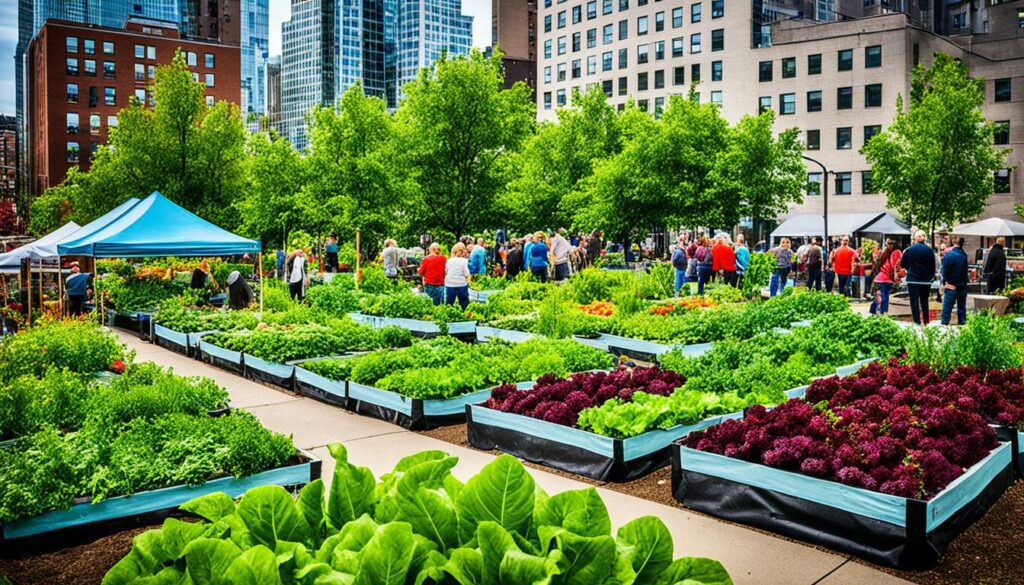
Teaching about city agriculture is key to making people eco-friendly. Programs like soil tests for community gardens show this. With $40,000 available, they can test 800 soils for free. Webinars, like the one on March 19, 2024, share important info widely. Also, groups like Cornell Cooperative Extension help out with know-how on growing food. They make community gardens great places to learn for all, from school kids to veterans. Such efforts make everyone smarter and ready to take care of their city.
| Benefit | Details |
|---|---|
| Health Promotion | Community gardens and urban farms expand access to fresh, healthy foods, thereby reducing hunger and improving local diets. |
| Economic Development | Urban agriculture drives the economy by providing jobs and boosting property values, while also promoting community engagement and crime prevention. |
| Environmental Impact | Urban agriculture reduces greenhouse gas emissions from food transportation and serves as a local food source during disasters. |
Community gardens are not just places to grow food. They’re at the heart of an effort to make cities safer and closer. By teaching and bringing people together, they help fight hunger and make a strong, united city.
Sustainable urban agriculture practices are key for strong, green food systems in cities. They rely on new ideas like saving water in city farming, cutting down on waste through composting, and using clean, renewable energy. Urban agriculture becomes a big player in making our cities eco-friendly.
City farming uses smart ways to save water. For example, it collects and saves rainwater. This means less need for city water. Also, farming uses drip and sprinkler systems to water plants directly, not wastefully. This helps save a lot of water.
Tackling waste well is a big part of urban farming. It turns food scraps and other organic waste into compost. Compost is great for the soil. It makes plants grow better. By doing this, urban farms cut down on waste sent to landfills and improve their soil without buying chemicals.
City farms also focus on using clean energy like the sun and wind. They have solar panels and wind turbines. This helps them use less fossil fuels. It’s good for the planet and makes farms more independent.

Urban farmers get big benefits from lots of resources and support. Various agricultural institutions help with technical and financial support. They take on the daily and long-term issues of innovative producers.
The USDA is key in helping urban agriculture with many support plans. The USDA Office of Urban Agriculture and Innovative Production updates initiatives to help producers. It puts a lot of money, up to $550 million from the American Rescue Plan, into supporting underserved producers and minority-serving institutions.
This includes $11.5 million for composting and food waste reduction in 23 states. It also includes $14.2 million for 52 urban agriculture projects.
Getting grants and funding is crucial for urban farmers. The USDA and other places offer money to improve urban farming. For instance, $22.6 million aims to make healthy food more accessible across the country.
The National Institute of Food and Agriculture (NIFA) gives $9.4 million for research and educational initiatives. Such funds help urban farms grow and do well in cities.
Urban farmers also need education and training to boost their know-how. The USDA offers help like extension projects and educational programs for urban farming. These resources keep farmers informed about the newest farming methods. They also help with crop insurance for controlled environment farming.
Learning is key for urban farming to face modern-day challenges. It helps farmers succeed and make urban farming work.
Using these resources for urban farmers, like the USDA’s massive support, helps urban farms a lot. It helps them overcome problems and reach their goals in urban agriculture.
Urban farming is set to change a lot because of new tech and forecasts. By 2050, 68% of the world will live in cities. Yet, cities only take up 3% of the Earth but hold over half the people. This makes the future of growing food in cities very, very important.
Future urban farming is all about new ideas. Things like vertical farming and hydroponics are really making a mark. The market for vertical farming could hit $16.7 billion by 2026. That’s because it’s growing at 25.7% every year.
Hydroponics, a way to grow plants without soil, is also on the rise. The global market could grow by 6.8% annually between 2021 and 2026. These advancements are not just efficient but also make the most of small city spaces.
Smart tech, like sensors and AI, are a big help in city farms. They make sure plants grow well, which means more food and less waste.
City farms also reuse waste for plant food and cut down on how much food gets thrown away. This is thanks to smart, sustainable practices.
In the future, city farming will be super high-tech and smart. More farms will use special ways to grow food, like controlled environments. This will help solve problems such as not enough land and water.
Places will encourage and help out by making it easier to have farms in cities. They’ll do this by changing rules, giving tax breaks, and funding projects.
There will also be a big focus on making farms ready for the climate. Green roofs, crops that don’t need a lot of water, and smart ways to use water are key. Looking for food grown nearby, called “locally sourced,” will become even more popular. This is because it fights hot city spots and helps make cities greener and safer.
As a result, the future of growing food in cities is exciting. It combines new technology with smart ways to use resources. This way, city farming can keep up with the growing need for fresh, local food.
Urban farming has great promise for fighting food security issues across the United States. It’s key in making sure cities are food safe by giving people locally grown, fresh food. With about 39.4 million Americans facing low income and struggling to get affordable, healthy food, urban farming is essential.
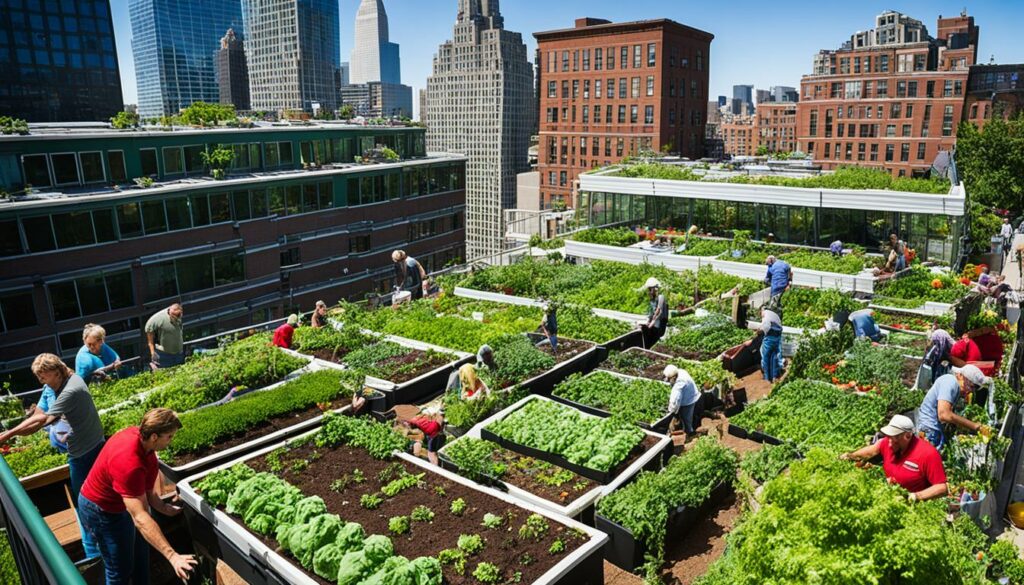
USA urban agriculture makes a big difference in places where many live in poverty. For example, in Maryland, they use rooftop runoff for farming and make sure the water is clean. This method shows how urban farming can help fill the nutrition gap in poor areas.
In some cities, urban farmers deal with many problems. In Baltimore, getting water for community gardens can be tough. Also, in Detroit, it costs a lot for farms to buy what they need to make the soil good. But, there are answers being found. For instance, planting without digging can grow bigger plants on city soil, as a study in Detroit found.
One big issue is finding enough land for farming. But, places like Maryland show it’s easier to find land than it is to get affordable water. Understanding this difference is very important as we try to use urban farming food security more in planning and making policies.
In the end, valuing USA urban agriculture and solving the challenges it faces can lead cities to a more secure, healthy food future for all their people.
Looking at urban farming in the USA, we see it brings big benefits. It helps cities be more resilient and green. It also boosts the economy and brings people together. Urban farms are doing a lot in different areas of the country.
When we look at the city agriculture scene, we find some interesting facts. The average urban farmer is 44. Men and women both play key roles, with 53% women and 44% men. Some also identify differently. Most farms have about three sites and produce a lot within the city.
About 65% of farmers are new to this in the last five years. Many own their land, but some just lease it. Urban farms support their communities beyond making money. They focus on having enough food, building strong communities, and teaching others.
In closing, urban farming is ready to make big changes in US cities. Overcoming problems like finding land and cutting emissions is key. With everyone’s support and new ideas, urban farming will keep growing. It will make cities greener, healthier, and more welcoming for all.
Urban farming means growing and selling food in cities. It uses city resources to feed people locally.
In the past, it fed people in cities. Its importance changed with city growth. Now, it’s part of living sustainably and locally.
The USA sees growth due to benefits in economy, environment, and society. Cities like New York lead by weaving farming into their plans.
It boosts the local economy with jobs and businesses. Also, by selling fresh food in cities, it supports the local economy.
It improves biodiversity and air. Methods like hydroponics save water and lessen the need for soil.
It brings people together in green places. This can help food security and community growth, especially for those who are underserved.
Land in cities is expensive, making it hard for farmers. They often have to make do with temporary spaces.
Urban farmers can find help from USDA, grants, and groups that offer advice and support.
Nonprofits help with technical advice, push for policy changes, and offer training. This helps farmers be more successful and sustainable.
Techniques include rooftop gardens, indoor farming, and hydroponics. They use space and resources efficiently.
They are shared spaces for growing food. They teach about farming and bring communities together, making urban areas more secure and cohesive.
It saves water, recycles waste, and uses renewable energy. This makes farming in cities sustainable.
The USDA helps with money and advice for many projects. They also provide grants and education for farmers to learn more.
New tech like indoor farming and smart systems improve how we farm in cities. They make farming both efficient and green.
It gives fresh food to city people, tackling issues like food deserts. It also teaches about eating well. These steps are vital for cities to thrive sustainably.